
Let us continue with the most important part of the test report, the highest possible stable performance. The test results are based on an ASRock X99 Extreme6 LGA2011-3 motherboard with an Intel Core i7-5930K CPU on different frequencies depending on the BCLK and RAM clock for the different memory benchmarks. Microsoft Windows 7 Ultimate Edition is used as the operating system. The stability was examined with the software Memtest86 and SiSoft Sandra Lite is used for all benchmarks, because it offers extensive adjustments and a fast result comparison. BTW. the latest SiSoftware Sandra version is available on our server and can be downloaded very fast. The memory benchmark tests are also included in the free Sandra Lite version.
DDR4 benchmark with SPD settings …
First, the memory modules are tested with the SPD values at default BCLK, whereby the values are programmed to the SPD IC by the manufacturer and read out from the motherboard. At default BLCK, the timings with the autosettings from the SPD EEPROM were set to 15-15-15-36 2T (CAS-TRCD-TRP-TRAS).
Here is a Snipping screenshot of CPU-Z 1.70 at 1066.10 MHz / DDR4-2133 and 15-15-15-36 2T with 1.20 Volt:
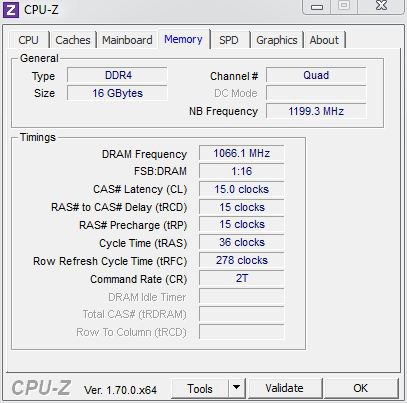
Here is the result of the SiSoftware Sandra benchmark tests:
| Default Frequency | Timing | Memory Voltage | RAM Bandwidth Integer B/F AVX2/256 | Memory Bus Range | Memory Latency |
| 1066.1 MHz | SPD 15-15-15-36 | 1.20 Volt | 17.38 GB/s | 17.06 GB/s | 26.6 ns |
The “Memory Bus Range” is by the way no benchmark value, but this value is quite simple to calculate by the frequency and is used only to compare the benchmarks.
This standard SPD clocking at the standard DDR4 voltage is compared with two other settings:
DDR4 OC with 1.20 Volt …
First, the maximum frequency of the memory modules is determined with default 1.20 Volt. The memory clock with a fixed memory timing of 15-15-15-36 2 T and 1.20V voltage is increased in small steps while the detailed Memtest86 test still runs without an error. The long trial period ensures that this frequency of the modules is working really stable.
The highest frequency with 15-15-15-36 2T timings and 1,20V was approx. 1249.3 MHz.
Here is a Snipping screenshot of CPU-Z 1.70 at 1249.3 MHz / DDR4-2500 and 15-15-15-36 2T with 1.20 Volt:
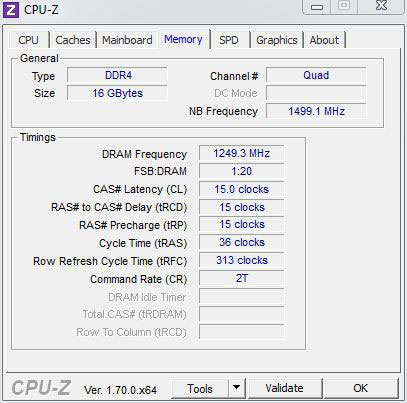
DDR4 OC with 1.35 Volt …
On the other hand the highest possible frequency was determined at 15-15-15-36 2T with the maximum permitted manufacturer voltage, which is however for these modules identical with the default voltage of 1.20 volts. Since overclocking is already outside the specifications, we decided for an OC voltage of 1.35 volts, to overclock the memory at least slightly higher.
With an increased memory voltage of 1.35 volts the DDR4 memory modules at 15-15-15-36 2T timings could be overclocked to 1400.60 MHz, which corresponds to approximately DDR4-2800. Officially the company Crucial specifies the default DDR4 1.20 volts, without loosing the warranty !
Here is a Snipping screenshot of CPU-Z 1.70 at 1400.60 MHz / DDR4-2800 and 15-15-15-36 2T with 1,35 Volt:
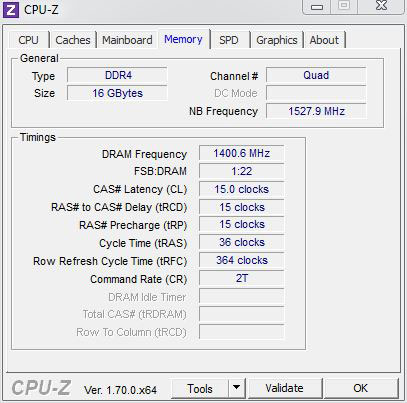
It is possible to run higher frequencies with increased voltages or lower timings, because the frequencies and timings depends directly from each other.
Here, the OC results are shown in a chart:
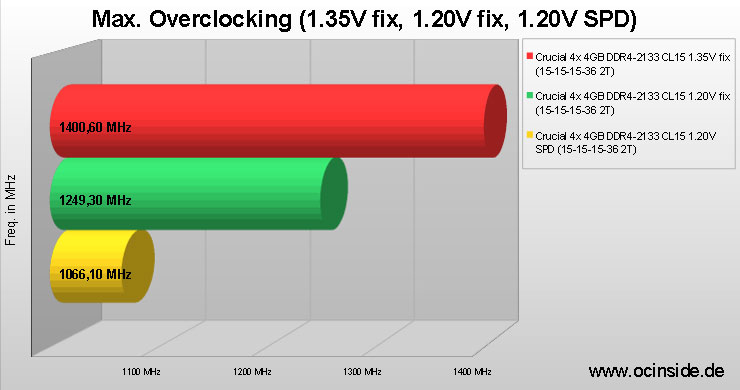
And here is a direct comparison of the OC values with the previously tested DDR4 modules. The officially permitted voltage of 1.20 volts was chosen as basis for this chart.
Here, a chart with all DDR4 OC’s values in the comparison:
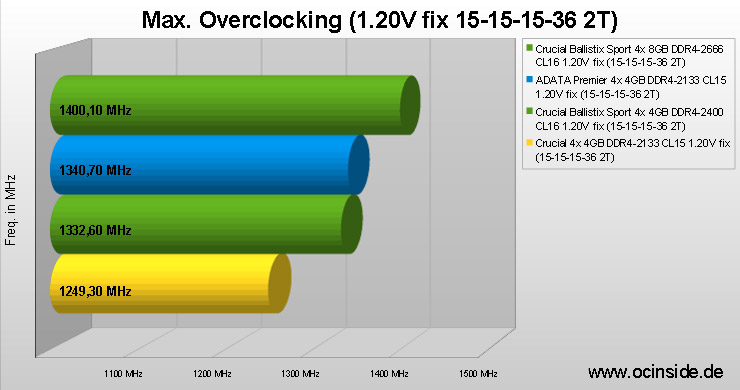
The DDR4 overclocking chart will be of course extended, when newer DDR4 modules are tested. Here we can already see, that the OC results are below the previously tested ADATA Premier 4GB DDR4-2133 CL15 modules, that we could overclock with 1.20 volts to 1340.70 MHz (DDR4-2684) and with 1.35 volts to 1400.60 MHz (DDR4-2800). The previously tested Crucial Ballistix Sport 4GB DDR4-2400 CL16 modules could be overclocked at 1.20 Volt to a higher value of 1332.60 MHz (DDR4-2666) and with 1.35 volts to 1400.60 MHz (DDR4-2800).
Crucial 16GB Kit 4x 4GB DDR4-2133 Results and general impression …

